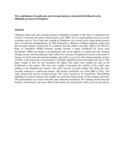Please use this identifier to cite or link to this item:
https://cris.library.msu.ac.zw//handle/11408/1797| Title: | The contribution of small-scale and artisanal mining to household livelihoods in the Midlands province of Zimbabwe | Authors: | Siwadi, Patience Mutanga, Marcus |
Keywords: | Household livelihoods Small scale minning |
Issue Date: | Jul-2013 | Series/Report no.: | International Journal of Management, IT and Engineering;Vol. 3, No. 7; p. 33-47 | Abstract: | Although small-scale and artisanal mining in Zimbabwe predates to the time of colonialism the country’s economic downturn which began in the 1990s saw an unprecedented increase in this economic activity. For a long time, mining in Zimbabwe was carried out by large mining houses most of which are multinationals. In 1992 Zimbabwe’s Minister of Mines legalized small-scale and artisanal mining countrywide on condition that the miners sold their yield to the Reserve Bank of Zimbabwe (RBZ) Informal mining became a major livelihood for many rural households. While the negative environmental and social impacts of small-scale and artisanal mining are now well documented, there still exists a lacuna of empirical research on the positive impacts of small-scale and artisanal mining, especially as a poverty alleviating economic activity yet there is the stereotype of associating it with high expenditure and extravagant life styles. This paper sought to find out and document the impact that small scale mining has had on the livelihoods of the miners. The study also sought to document the viability of the small scale mining in the Zimbabwean context. The study focused on gold mining, this being the most favoured mineral by small-scale miners. The period considered was from 2000 to 2012. The study adopted the survey research design. The study focused on 41 households. Snowballing sampling was done to reach at the sample size given the illegal nature of these mining activities. The questionnaire was used as the main data collection instrument. The findings showed that the majority of the miners were men. Most of the miners are young, below thirty years of age and are ... | URI: | http://search.proquest.com/openview/c973596081217b40bff40b6bb4f8c921/1?pq-origsite=gscholar http://hdl.handle.net/11408/1797 |
ISSN: | 2249-0558 |
| Appears in Collections: | Research Papers |
Files in This Item:
| File | Description | Size | Format | |
|---|---|---|---|---|
| minning.pdf | Abstract | 12.5 kB | Adobe PDF |  View/Open |
Page view(s)
86
checked on Feb 26, 2025
Download(s)
32
checked on Feb 26, 2025
Google ScholarTM
Check
Items in MSUIR are protected by copyright, with all rights reserved, unless otherwise indicated.


